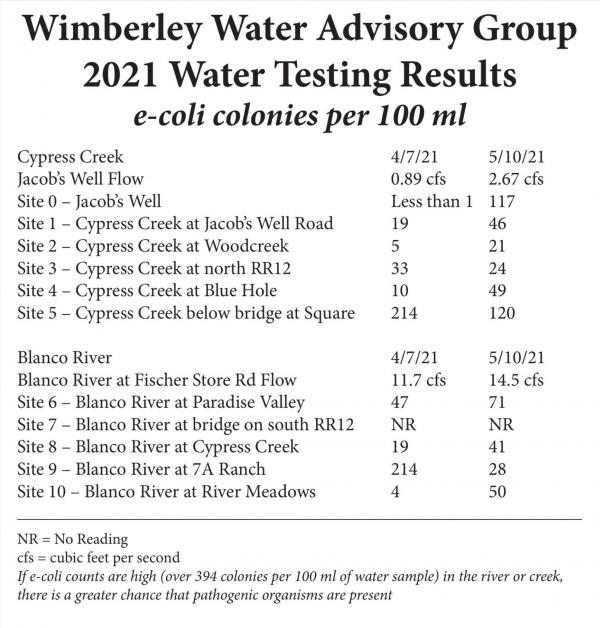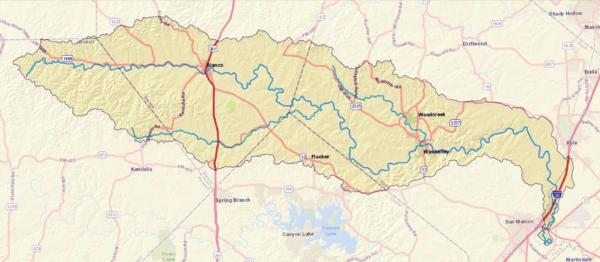Solutions to Blanco wastewater discharge seeing new light
The impact of the election May 1 on Blanco citizens and their Wimberley Valley neighbors downstream along the Blanco River was immediately apparent at the city’s May 11 council meeting under new mayor Rachel Lumpee, joined by new council member Connie Barron. A council previously struggling to address its first municipal utility district (MUD) achieved a number of water and wastewater planning objectives for Blanco that will directly benefit Hays County.
The Blanco City Council adopted a MUD policy that had been tabled before the election, ensuring infrastructure standards for new developments that promote water quality. The council initiated a companion development agreement policy, which if passed will set expectations for negotiations with developers on details about what gets built in a MUD. To deal further with immediate issues, the council directed staff to compile water, wastewater, and planning data toward a moratorium on major development and to work with a consultant on a proposal to evaluate city administration.
The actions bolster the regional Blanco Water Reclamation Task Force, established by the council in September. The cooperative effort, facilitated by Nick Dornak of The Meadows Center for Water and the Environment at Texas State, has included council members Deda Divine and Matt Lewis, interim city manager Will Daves, and utility director Ronnie Rodriguez, along with Protect Our Blanco representatives David Baker and Joe Day of Hays County, and John Ransom and Gabriel Gregerman of Blanco.
Through the task force, Hays County has funded an engineering study for shortterm water and wastewater in Blanco to ensure no discharge into the Blanco River. Commissioner Lon Shell, Pct. 3, explained his rationale behind County sponsorship of the study: “The river doesn’t know where the county line is. It goes through Hays County and is important to the Wimberley Valley—all of the county—on to San Marcos, and anything that might damage it is worth our attention. It’s connected to our groundwater, and we want to make sure that we have the cleanest groundwater that we can.” MUD Conditions to Mitigate Development
The Blanco Council’s MUD Policy formalizes the city’s ability under Texas Water Code to require conditions on water, wastewater, road infrastructure and financing, in exchange for the City’s consent to the MUD. State law does not allow a city to prevent creation of a MUD in its extraterritorial jurisdiction outright. If denied, a developer could create the MUD through the Legislature or Texas Commission on Environmental Quality. Barron led the charge on the policy’s Dripping Springs-inspired language, sponsored prior to the election by council members Divine and Keith McClelland. In moving for passage, incumbent Mike Smith described the initial policy as important to have in place while further improvements are “merged” in from a 2018 Georgetown resolution.
The policy contains expectations of a 30-day notice and pre-meeting with the City before the filing of a MUD petition, payment of City expenses, and essential drawings and documentation. Provisions preserve the quantity and quality of groundwater and streamflow in the Blanco River, and set environmental goals for development that protect critical natural features and provide open spaces for aquifer recharge, buffer zones for creeks and rivers, and parks and trails.
The council also took up development agreement policies from Buda, Seguin and Bastrop provided by city attorney Brad Bullock, who agreed to work with Barron on a version tailored to Blanco for future consideration. A policy on such agreements would set the tone for negotiated cooperation between the City and a MUD in its ETJ, including the 385-acre Blanco County MUD #1, which received City consent with conditions in January and proposes to double the city’s population.
Beyond MUDs to Better Management
McClelland sponsored discussion of a 90-day moratorium on major development, which revealed that a revised site plan may be imminent from the MUD. This comes as water supply remains re-duced during construction of a new treatment plant projected for March completion. To assess justification for the moratorium, the Council authorized a staff report on water and sewer capacity, along with a schedule of anticipated development.
Lumpee leads as mayor after three years’ reporting on the council for Blanco County News. She campaigned in part on support for the task force, and promised greater transparency, including an updated City website with meeting agenda packets and recordings. During her year on the Planning & Zoning Commission, she called for more public input and professional consultants to aid with comprehensive planning.
A final agenda item in open session introduced consultant Kelly Kuenstler, a former city manager and UTSA adjunct instructor in public administration. Kuenstler conducted an informal inquiry from the podium into Council concerns about city administration. She was given general assent to interview city staff and offer a proposal to the Council at a special meeting before the June 8 regular meeting.
New Thinking for Positive Change
The shift in council perspective coincides with a draft report to the task force from consulting engineer AquaStrategies. Framed as a TPDES (Texas Pollutant Discharge Elimination System) Refinement Study, the report looks at population and demand growth in context with water and wastewater infrastructure and permits. From that evaluation, AquaStrategies is estimating costs for no-discharge options, including current land application of treated effluent irrigating hay fields, line extensions for additional irrigation, and commercial sales of treated effluent.
Longer term options may include constructed wetlands, advance treatment to drinking water quality, and decentralized wastewater for new developments. That final option mirrors “One Water” principles included in Wimberley ISD’s Blue Hole Primary School. Its wastewater stays on-site and is treated and reused as graywater before final use as subsurface drip irrigation, eliminating any sewer connection and most need for groundwater.
The cooperation of the task force across counties is a welcome change from previous years’ disputes over the river’s condition and discharge permits, said Shell. “We have good relationships. The floods impacted Blanco and Hays counties most severely in 2015, and brought us all together, made us realize what was important. Now growth is becoming extreme for them, too. We understand the struggles. Obviously, Wimberley and Dripping Springs have had wastewater challenges. We’ve all been there. It’s good to see everyone respond positively.”
Ray Don Tilley is the Creative Director for the Wimberley Valley Watershed Association. The Water Column is a monthly submission from WVWA addressing water issues pertinent to the Wimberley Valley.



